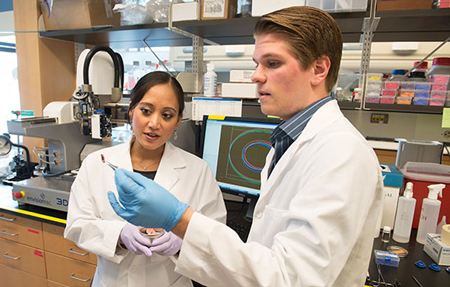Printing Clean Energy One Fuel Cell at a Time
Northwestern Engineering senior’s research opens door to new fuel cell fabrication techniques
With 3-D printing changing the world, one Northwestern University undergraduate spent this past summer in the lab doing his part to use this exciting new technology to create efficient and economic energy.
Nick Geisendorfer won an undergraduate research grant to employ 3-D printing technology to test the possibilities of making a particular kind of fuel cell more efficient and marketable.
He thinks solid oxide fuel cell (SOFC) technology, which produces electricity from the electrochemical oxidation of fuel without burning, could be an answer in the race to reduce carbon emissions.
“Not many people are really researching this or trying to fabricate fuel cells this way,” the McCormick School of Engineering and Applied Science senior said. “This research experience this summer at Northwestern has really helped me figure out my future path.”
He found himself in the right place to push the limits of his research questions.
 Geisendorfer’s mentor and academic advisor is Ramille Shah, a renowned scientist and faculty member of both McCormick and the Northwestern University Feinberg School of Medicine. She leads the Tissue Engineering and Additive Manufacturing Lab, where she uses 3-D printing to create new biodegradable materials and scaffolding for use in regenerative medicine, as well as unique functional 3-D inks to be used for energy and advanced structural applications.
Geisendorfer’s mentor and academic advisor is Ramille Shah, a renowned scientist and faculty member of both McCormick and the Northwestern University Feinberg School of Medicine. She leads the Tissue Engineering and Additive Manufacturing Lab, where she uses 3-D printing to create new biodegradable materials and scaffolding for use in regenerative medicine, as well as unique functional 3-D inks to be used for energy and advanced structural applications.
“It’s more of an art than people realize,” Shah said. “You can’t just press go and expect the printer to create exactly what you want. Nick has put in a lot of time and really perfected the printing process.”
Previously named one of Crain’s Chicago Business’ “40 under 40,” Shah has watched Geisendorfer become one of the most skilled printers in her lab.
Geisendorfer is also collaborating with McCormick professor Scott Barnett, whose lab at Northwestern focuses on improving fuel cell performance.
Guided by the expertise of Shah and Barnett, Geisendorfer’s interdisciplinary project has not only helped him discover new techniques for fabricating SOFCs but also determine his plans for the future.
This is another in a series of stories profiling Northwestern undergraduates who received 2015 summer Undergraduate Research Grants. Read more in a Q&A with Geisendorfer, who recently spoke to Northwestern News about his research and reflected on his time at Northwestern.
How did you get interested in research?
I was initially hesitant to get involved in research. I thought, how could I -- an undergrad who basically knows nothing -- possibly assist these eminent faculty members with this work they are doing? But someone told me, “No one expects undergrads doing research to find answers. They only expect you to have questions.” That lit a light bulb inside of me. “I have questions -- I can ask a lot of questions.”
How do SOFCs provide energy?
An SOFC is similar to a battery. The main difference between them is that SOFCs are made up of completely solid materials, where batteries generally contain liquid. Another key difference is that batteries have an exhaustible capacity, while SOFCs will generate electricity as long as they are supplied with fuel. Fuel cells in general are very efficient -- much more so than fossil combustion.
What could SOFCs provide electricity for?
SOFCs are mostly intended for stationary power. They’re different than the fuel cells you might put in a car. It could be the sort of thing where you buy a stack and put it in your basement to power your house, but it’s mostly thought of as a large-scale energy solution.
Where are you now in your research?
We’re testing a lot of different designs and figuring out what really works. I’ve been doing a lot of 3-D printing and really worked out a lot of kinks in that respect. SOFCs have existed for a while, but no one has come up with a super good way to make them into complex designs. We are looking at how we can either 3-D print a whole cell or incorporate 3-D printed fuel cell parts into the work being done by Professor Barnett’s lab.
What’s it been like working with Professor Shah this summer?
It’s been great. I’ve been able to meet with her, discuss the project and the direction it’s headed. Meeting and working with Professor Shah has been really significant to my undergraduate experience.
How has doing research as an undergrad impacted your time at Northwestern and shaped your future?
Solving research problems is very different from solving homework problems. I’ve found that having a place to apply materials science knowledge has been profoundly impactful and has changed how I approach my studies. I approach everything with a different mindset now. Knowing that I like research, and knowing I want to continue to do it after this, is a really positive reinforcement for a desire to go to graduate school.